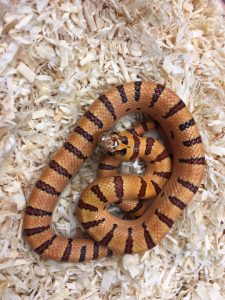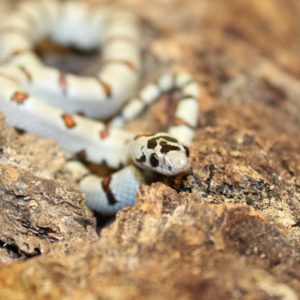Copyright 2021 Evolution Reptiles
All rights reserved.
Copyright 2025 Evolution Reptiles
All rights reserved.
All rights reserved.
The Thayers king snake is a small, gentle species of king snake found in the Tamaulipan desert areas, in habitat very similar to the limestone rock outcroppings of western Texas and New Mexico favoured by L. alterna, the Gray-Banded Kingsnake. Although their home is rocky and dry, they are not a true desert species.
They are – as one of the common names suggests – extremely variable in appearance; there are three main types, the milksnake phase, Leonis phase (sometimes known as the Nuevo Leon Mountain Kingsnake), and black, or melanistic, phase. All three can apparently be found in a single clutch, depending on the variability of the parents.

Adult Thayers reach a size of between 90 and 120cm/3 to 4 feet, although usually on the smaller end of this. They will require a vivarium of at least 90cm (38”) in width, with the traditional wooden vivarium retaining heat better than the newer glass types.
Like all reptiles, Thayers king snakes appreciate a temperature gradient which can be provided in two main ways. A deep heat projector at one end of the vivarium and thermostatically controlled will provide gentle heat, and if this is combined with a small heat bulb there will be a daytime temperature peak similar to what the snake would encounter in the wild. Remember to always check your temperatures using a good quality digital thermometer – never guess. Although it has always been assumed that snakes do not need UV lighting, it is always a good idea to provide it. Low output T5 UV tubes are now available that can mimic the levels of UV that they would be exposed to in the wild, and we have found that when it is provided they will definitely use it.
The ideal temperature for the warm area in your snake’s vivarium is around 27-31°C (81-91°F). The cool end can be up to 10º cooler. Like most snakes, Thayers will appreciate a slight night time drop in temperature.

Thayers king snakes are a shy species that appreciate a large number of hiding places. Any of the dry substrates – with the exception of sand – are suitable, although they do appear to like the substrates that they can burrow in (aspen and lignocel). With regular, gentle handling Thayers can become very tame, and make excellent pets.
Two hides are often recommended, one at the warm end and one at the cool; for shyer species it is better to provide more than this. A choice of several different hides allows the snake to thermoregulate whilst remaining secure. A moist hide (sometimes called a shedding hide or a wet box) is a hollow hide made of resin or plastic that contains damp moss. Placed at the warm end of the vivarium this gives your snake a personal sauna that they will often use when shedding.
The wild Thayers king snake is a great generalist – they eat lizards, rodents, and other snakes. Even in captivity some do seem to prefer lizards, although even they can be coaxed into eating rodents if the mouse is scented using shed lizard skin.
Feed your snake one defrosted mouse every 1-2 weeks. The mouse should be no bigger than the largest part of the snake. Thayers king snakes can eat mice their entire lives – starting off with pinkies as a hatchling and moving up in size as the animal grows. As these snakes have a narrow head, they often prefer several smaller prey items at a time as adults rather than a large mouse.
The simplest feeding technique is to place the defrosted food in the vivarium near the snake and leave it to feed. The other way is to offer the food on some tongs or tweezers to the snake; they will often strike very quickly then constrict the mouse. Snakes sometimes refuse to feed while shedding.
Smaller than the more common corn snake, the Thayers king is a keen feeder but not as greedy as its cousin the California king snake! Gentle and docile, this little species is a great starter snake, as well as being something a little bit different for the experienced hobbyist.
Copyright 2021 Evolution Reptiles
All rights reserved.
Notifications